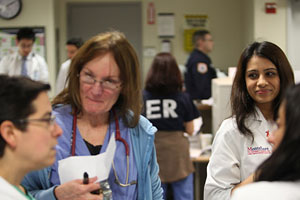Emergency Medicine

The Emergency Department at Montefiore Medical Center is one of the top five busiest in the United States and the most-visited in the state of New York. Drawing approximately 275,000 visits from patients age 21 and over each year from Westchester, Manhattan, Connecticut, and the Bronx, our board-certified physicians' dedication to providing excellent emergency services to the surrounding community is unsurpassed.
Patients come to our Emergency Department with a broad spectrum of ailments and injuries, ranging from cold symptoms to heart attacks. Our cardiac services are particularly remarkable, as we offer the highest possible level of care, with the availability of emergent cardiac catheterization 24x7, an Arrhythmia service, a Congestive Heart Failure service, and the performance of cardiac transplants.
Additionally, we are a recognized leader in stroke services, with a specialized team of stroke specialists, much like our cardiac group. On call 24/7, seven days a week, our stroke experts cater to patients who are candidates for thrombolysis, the powerful clot buster medication.
Due to our high volume of visitors, we recently expanded the Emergency Department footprint with an additional 18 treatment rooms.
What to Expect Upon Arrival to the Emergency Room
The first and most crucial step to admitting a patient to the emergency department is triage, where a highly skilled nurse consults with and evaluates patients, reviews history, and determines the severity of each case. We have several triage booths to expedite patient care. Additionally, our triage and registration are joined together as one process, in order to maximize efficiency and minimize wait time.
Depending on the degree of the illness or injury, patients are brought to different areas within the Emergency Department. For example, our Fast Track area is for patients with minor problems such as ankle sprains, upper respiratory infections, and minor injuries. Likewise, we have a distinct area for asthma patients in need of immediate treatment. Our 'wall of oxygen' accommodates multiple nebulizers, so asthma patients may bypass the waiting area and be directly escorted to this location. We even have a separate psychiatric emergency room for patients with uncontrolled behavior, hallucinations, manic episodes, major depression, and suicidal ideations. Each of these specialized areas expedites patient treatment and enables them to return to their daily routines as quickly as possible.
For more significant issues, including life and limb threatening conditions and injuries, patients are brought to the main emergency room, where a team of board-certified and Emergency Medicine trained physicians, nurses, and social workers collaborate together to address various patient care needs. These include: abdominal or chest pains, trauma, and acute migraines to name a few.
State-of-the-Art Technology
At Montefiore Medical Center, we have the most-advanced diagnostic and therapeutic equipment to manage any severity of any illness. Many other emergency services can boast similar technology, but when it comes to cardiac care, our Emergency Department is at the forefront. Within 10 minutes of arrival to triage, our patients receive an EKG in order to identify whether or not the case is a heart attack. Upon the attending physician's diagnosis, he or she will contact an entire team of catheterization physicians and cardiac fellows on Nextel cell phones so patients, if need be, can be admitted immediately to our dedicated catheterization laboratory for emergent treatment.
We utilize the Online Paging Grid, so our nurses and physicians can page one another with just a click of a mouse, rather than calling the operator and risking being placed on hold. Additionally, this system enables doctors to enter as much information as possible, so the receiving nurse or physician understands which patient and what condition is in need of attention, what number to call and what clinical information needs to be relayed. All of the Emergency Department attendings carry Nextel cell phones so that they may be reached directly rather than have a secretary answer and transfer the call.
Additionally, we employ Physician Order Entry so doctors can order blood tests, CAT scans, X-rays, and ultrasounds from a computer terminal. In addition, we have state of the art technology that allows the staff to view the actual x-ray and CT scan images from any computer terminal. Our Patient Tracking System permits all emergency department physicians and nurse access to information such as: which bed each patient currently occupies, how long each patient has been there, who the attending physician and nurse is, whether they are waiting for bed, and if laboratory results are pending. This way the entire emergency room process is streamlined, so each patient can receive the most efficient care as possible while here.
Advancements in Research
One of our key missions at the Department of Emergency Medicine is continuing ongoing, specialized research projects and utilizing our Quality Improvement Program to continuously evaluate the quality of care we are providing. We have a team of research assistants around the clock to support our research efforts.
We are currently exploring different regimens of medications for acute pain to determine how to best treat our patients. We also have an attending physician conducting an ongoing clinical study to analyze smoking cessation in order to help smokers achieve their goal of quitting. They are supplied with patches, counseling and follow-up consultations to track their progress.
Another attending physician, Dr. Friedman, conducts clinical studies in migraines, nausea, and acute lower back pain. The findings from most of our studies have been published in the emergency medicine literature and other medical journals.
We are also a major teaching unit of Montefiore Medical Center with one of the largest Emergency Medicine residency programs in the country. The academic life of the Albert Einstein College of Medicine and the Medical Center are actively integrated into one another to maximize the learning experience and cultivate the emergency physicians of tomorrow. We also provide ongoing health care, information, and education to the surrounding community in order to best prevent any future trips to the Emergency Room.



